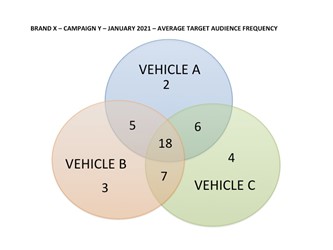Let's Not Underestimate Our Ability to Control Frequency Now

At CIMM's 10th annual Cross-Platform Video Measurement & Data Summit, CIMM CEO Jane Clarke, P&G's Kanishka Das (KD), ANA's Artie Bulgrin, MRC's Ron Pinelli and an equally all-star cast brought the industry up to date on the WFA/ANA/ISBA field trials of the new global cross-media measurement platform. I'm very happy to say that the project strikes me as operating in a most thoughtful, world-class manner, and welcoming in more and more collaborators from across the industry.
This will be a new flexible platform that all can share while expressing their individual differences.
The transition has been planned so that there will be no damage to any parties. That was careful thinking.
The core benefit that everyone remembers as the prime mover of the project is to improve the ability to impose effective frequency caps. So fewer citizens get turned off to a brand that is perceived to have bombarded them. (I use "citizens" following Rishad Tobaccowala's thinking expressed at CIMM.)
Yet the platform will have far more benefit than that:
- It will become a common language.
- It will offer the best-of-class data and analytics.
- It will protect privacy to the hilt -- even adding noise on purpose.
- It will have economies of scale.
- It will not have a monopoly because it will coexist within a galaxy of other data and analytics constantly evolving literally day to day. Whole new companies will spring up competing to combine all your data and analytics on your phone.
"Ahh! But it's how they are combined!" they will all say.
And in fact, by espousing both panels and big data, the platform indicates that all the JICs in the world have nodded agreement to legitimizing big data to such a degree. That is a positive world change for the industry. Everyone was of course always using big data. But it sat at the kid's table.
Now will come the data science math games to put the datasets together using AI with more empirical science to optimize how panel and big data are best combined. The old-fashioned way of conforming big data to small data -- given the reality of the majority of the world population would never join a panel -- is not a world class notion.
The platform makes it easy to test out different notions of how to combine big and little data. And it will create a consensual reality that shall be calibrated to empirical reality better and better over time.
Action Item
Given that it will be years before all of these things have come to pass, I'll now shift to focusing on what I think we should be doing in the meantime.
In this post, let's tackle the main event, frequency capping. How can we do that better today than we have been doing it?

Going back to the roots of reach frequency (RF), it has always been possible to accurately estimate frequency received by specific cohorts. In the figure above, you can see that before further dicing, there are seven naturally occurring cohorts for which we would want to estimate frequency. That's because of the way that audience duplication works. With just three media vehicles you have seven natural frequency cohorts.
Today it's common to have hundreds and thousands of media vehicles operating at the same time for a single campaign. But math that has been around a long time, and has been applied in creating measurement and analytic technologies for a half century, deals with the problem either by deterministic measurement, or estimation using probability theory (known in EMEA as Sainsbury) and canonical duplication patterns between pairs, etc. (known in EMEA as Agostini). In the U.S. canonical cume curves have been developed and improved. From this body of work plus new methods we are able today to come very close to the RF data that will come from the platform.
I'm writing this here so that in the day to day we can accelerate a large part of the achievement sought as one of the reasons the platform is needed.
We can estimate the campaign frequency and size of any cohort that can be defined operationally. My company has built a system OptiBrain to do that right now with any panel or big data in the world. However, many of you reading this right now already have similar systems -- or your agency does. I recommend that you start there and find out what tools you already have to start whacking away at the excess frequency problem yourself, right now.
One benefit will be greater reach, so long as you do not increase the CPM against your target. Whatever comes out of frequency goes to reach. Without spending more, you get more reach.
You'll need to shift more from non-addressable to addressable media as soon as possible to achieve this. You can't shift it all to addressable because addressable TV doesn't yet reach everybody (OTT part reaches ~80 million homes in U.S., MVPD addressable TV reaches ~60 million), so you have to leave a lot in linear TV to maximize target reach with premium impact. If you buy correctly in addressable media, your CPM against your target will go down, not up.
Cable MVPDs have very little geographic overlap with one another, so if you set frequency caps within Cable MVPD addressable TV silos, spill-in from another Cable MVPD addressable TV silo will be negligible. No such natural guardrails exist with any other media types. Frequency will spill into any buy you make from all your other buys. You are best off to get the controlled frequency you want with the best targeting and context resonance with the fewest high-impact (premium) media.
Most buying today is quite different, with tons of excess impressions bought without regard for context resonance and most of it nonpremium, having shallow impact. This results in mammoth overages in frequency, although impact and reach typically both fall short. This is why optimizers are important.
The most recent study shows the ROAS dominance of TV and Advanced TV over other addressable media so in all analyses make sure to look at it by media types as well as by cohorts and creative executions.
Even though the addressable suppliers of premium video, nonpremium video and display do tend to be siloed, the existing RF estimation technology of the world masters this siloing problem with very decent estimates. That's close enough to rely upon for improved decision making. It is probably already available to you right now and something you can gin up with little effort and big gain.
Because the big benefit is the better citizen experience with your ads. That's what motivated the advertisers of the world to rise up and make the platform happen. And guess what? It will work. That and the evolution of even more empathetic creative will in time make citizens far more receptive and friendly to advertisers than ever before. It will show itself in ROI and in brand equity, therefore in stock values and the overall world economy.
Click the social buttons to share this story with colleagues and friends.
The opinions expressed here are the author's views and do not necessarily represent the views of MediaVillage.com/MyersBizNet.


